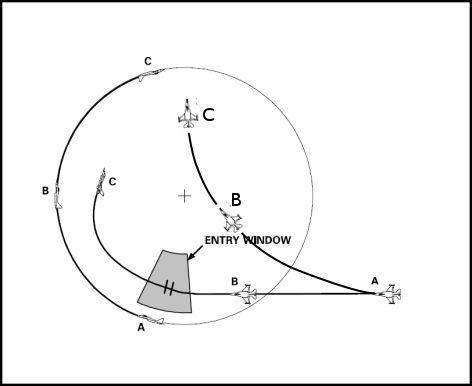What it looks like to me is that the attacking plane flies a lag pursuit on the defending plane at B and all the way up until just before C. Then at C the attacking plane starts pulling inside the defenders turn to a pure or even lead pursuit. At C the attacker could have continued a lag pursuit to stay locked on the defenders six, but it looks like they wanted to keep this diagram short and simple and had him pull for a pure pursuit. I'm assuming both planes in that diagram are at Co-E and have at least roughly the same turn rate (or radius I don't know which of these turning terms is correct), so there's no risk of overshooting from having too much speed or a worse turn rate and it's all about the angles.
If that's the case then I think I see what FLS is saying. Fly BEHIND the post to position yourself BEHIND your opponent. Fly IN FRONT of the post to fly IN FRONT of your opponent and try for a snap shot. It really is that simple, it's just a little hard to see it in your head. I only got it after looking at FLS's diagram for a bit.
Look at the image in sections instead of a whole and it might make a little more sense. Look at where both planes are and where they're pointed at in points A, A and a half, B, B and a half, and then C.
A looks like a lead pursuit possibly from trying to line up a shot before the turn.
Half way down A's path the defending plane is directly off the attackers nose which makes it a pure pursuit now. The attacker does not turn with him and instead enters a lag pursuit to enter BEHIND THE POST.
B the attacker still has yet to turn as he continues to fly a lag pursuit to enter BEHIND THE POST. The attacker is trying to match his turn circle (or flight path if that makes more sense) to the defenders turn circle (flight path) by flying the same path as him.
Halfway down B's path the attacker has now started his turn and keeps in lag pursuit to match turn circles (or flight paths). The attacker enters BEHIND THE POST because he's aiming to get on the defenders six before he shoots.
C the attacker starts pulling to a pure pursuit and his nose is now pointed at the defenders six. He gains the defenders six from flying lag pursuit and entering BEHIND THE POST.
I hope FLS doesn't mind me drawing graffiti all over his pretty diagram.


Now here's entering AHEAD OF THE POST.
At Halfway through A the attacker continues pulling his lead turn for a shot instead of dropping back to lag pursuit.
At B the attacker is still pulling lead and enters AHEAD OF THE POST. See the difference in between the two B's? When he enters BEHIND THE POST he's positioned more towards the defenders six. When he enters AHEAD OF THE POST he's getting further from the defenders six.
Halway through B the attacker is still pulling lead and getting further from the defenders six, and then at C we can see the classic snap shot that we've all taken many times before. The defender is flying across the nose of the attacker giving the attacker a snap shot. However, the attacker has made it a lot easier for the defender to avoid this shot by entering BEFORE THE POST. If the attacker misses his shot then he will overshoot and the defender can then become the attacker. Entering BEHIND THE POST keeps the attacker on the defenders six and makes it harder for the defender to force an overshoot.